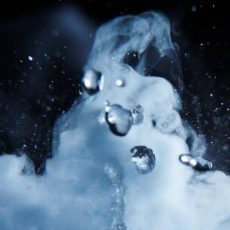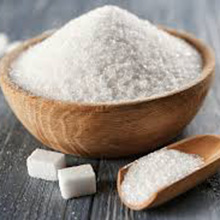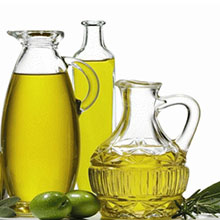Sugar Industry
EVP Liquid ring vacuum pump in Sugar Industry & Technology
From Plant to Juice
Sugar Cane:
After harvesting and delivery to a sugar mill, the cane is washed, chopped, and shredded by revolving knives.
The shredded cane is then repeatedly mixed with water and crushed between rollers. The juice is collected and the remaining fibrous solids (called bagasse) are burned for fuel and used for papermaking. EVP pumps are used in these processes as well.
Sugar Beets:
After harvesting and delivery to a processing plant, the beet roots are washed, mechanically sliced into thin
strips called cossettes, and passed through a diffuser to extract their sugar content into a water solution. The used cossettes, or pulp, is pressed down to 75% moisture,recovering additional sucrose and reducing the energy needed to dry the pulp. The pulp is then dried
and sold as animal feed.
Rotary Vacuum Filters
Extracting available sucrose from the mud at the bottoms of clarifiers (filters) is usually a rotary drum filter operation.EVP vacuum pumps are the preferred auxiliaries for these filters in the sugar industry – as they also are in many other industries. Moisture in the vacuum line – even soft solids – will not damage a EVP vacuum pump.
Vacuum requirements are well within the range of single-stage pumps.Typically, a rotary vacuum filter requires a vacuum of about 18” HgV (405 mbar abs) at the wash section and
about 10” HgV (675 mbar abs) at the pickup section. Allowing for pressure drops, this usually means about 21”HgV (303 mbar abs) at the pump inlet.
With one vacuum pump serving both sections, the reduced vacuum at the pickup section can be maintained with a vacuum regulation valve.
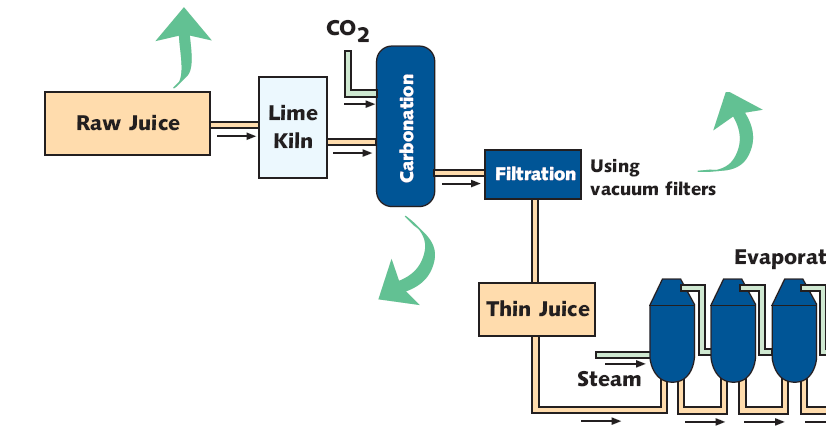
Compressors for Carbonation
The raw juice is mixed with hot milk of lime to precipitate a number of impurities. Next, CO2 is bubbled through the alkaline sugar solution, precipitating the lime as calcium carbonate. With EVP liquid ring compressors
• CO2 can be introduced at a constant pressure
• CO2 quantity can be precisely regulated
• Small amounts of lime dust are easily handled with no pump damage
• No lubrication oil is carried over to the juice
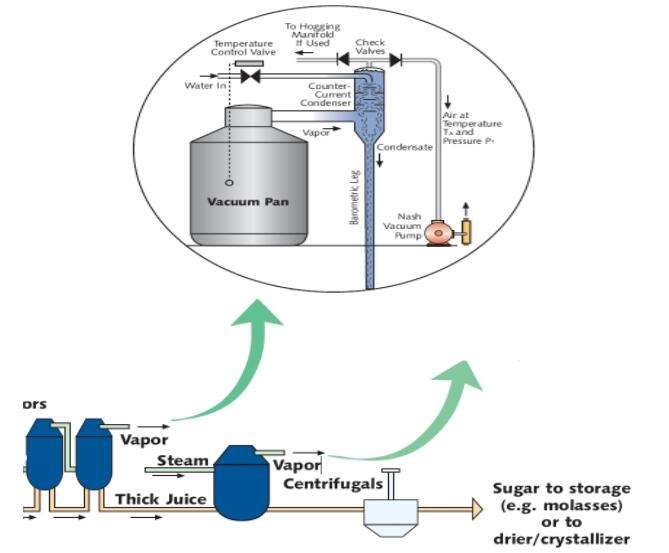
Drawing Non-Condensables Off Condensers
Vapor, air and other non-condensables can be drawn off evaporators and vacuum pans in several ways. The modern approach is to evacuate counter-current condensers with EVP single-stage vacuum pumps.
In a wet vacuum system like this, a EVP vacuum pump serves as a secondary condenser. Liquid compressant in intimate contact with the saturated air condenses most of the vapor that was not removed in the counter-current condenser. The significance of this is that transforming vapor into liquid decreases the volume that the pump must handle. Its effect is to decrease the size of the pump required by increasing the EVP pump’s capacity significantly beyond its dry air rating. How much added capacity can be attained depends on how cool the liquid compressant is with respect to the temperature of the incoming air-vapor mixture.
Simple & Dependable
The high cost of shutting down a plant operation in the middle of a campaign leads sugar refiners to seek out the simplest, most dependable equipment available. They choose EVP vacuum pumps and compressors.
• Slugs of liquid carryover can be handled without damage
• Vapor is condensed into a liquid
• Gas is cooled and scrubbed by the compressors,delivering clean, oil-free gas
Better Sugar Crystallization
The characteristics of EVP vacuum pumps and compressors enable you to achieve more uniform sugar crystallization.
• Product can be upgraded
• Color is better
• Production at lower cost
Materials of construction
This is an application that demands some care in material specification.Carbonic acid is produced when CO2 is mixed with water. Corrosive sulfur compounds come through with flue gas from sulfur-bearing fuels. Either can make trouble, and both together are most likely to attack ordinary materials unless suitable precautions are taken.
If the gas stream contains hard particles, they will subject equipment to abrasive wear. A successful remedy for this is to install a wet scrubber ahead of the
compressor.
If a cast iron compressor is used, it should be protected by pH control of the liquid compressant seal water.Adding soda ash to the water and pH monitoring are recommended.These precautions will extend a cast iron compressor’s life from one or two campaigns to more than four. Many years of service are reported with lime kiln gas and where flue gas does not have a high sulfur content.
Stainless steel is the most durable material for CO2 compressors.
If you are seeking long compressor life and a virtually trouble-free system, specify stainless.
Your objectives for equipment life, your budget for initial equipment cost, the level of your system maintenance,and the composition of your gas mixture all should be considered. Ask your EVP technical representative to study the tradeoffs so that you can make the best choice in terms of your own operating conditions.
(The article comes from the Internet. If reprinting is not allowed, please contact our company to delete it.)

